 |
Lehle |
| Feature |
Details |

|
Battery operation passible
These products can be operated either using a 9V PP3 battery or an external power supply
If the voltage of the external power supply drops below 9V a gold-plated relay automatically switches to battery operation. |

|
Gold-plated relay and switch contacts.
The signal from the pickups of an electric guitar and bass is so weak that poor-quality cables,
cold joints and cheap contact materials ruin your sound.
Switch contact need to be made of special materials to permit loss-free switching of these low-level signals.
All Lehle switchers feature special relays and slide switches with gold-plated contacts for totally reliable,
absolutely zero-loss switching. |

|
The Lehle LTHZ transformer.
Hum loops and phase cancellations can occur as soon as the signal from an instruments fed to more amp simultaneously.
The one and only remedy for this is a high-quality transformer.
Standard transformers modify the tone of electric guitars and basses very severely,
since they are not designed to handle the low-strength high-impedance signals generated by instrument pickups.
The lehle LTHZ, on the other hand, has been specifically conceived for use with these high-impedance signal,
preserving intrument tone and the interaction between instrument and amp and eliminating hum loops. |

|
Goodbye to hum loops.
All Lehle products not featuring an LTHZ transformer and bearing this symbol switch the signal ground parallel
to the signal itself via switches or relays with gold-plated contacts.
Hum loops are thus effectively eliminated when switching backwards and forwards between different signal sources without,
for example, simultaneous activation of two amps. |

|
Stereo.
Many effects units feature stereo outputs.
Or: instruments frequently have two pickup systems, e.g. a combination of conventional magnetic and Piezo types,
to emulate an acoustic sound. Lehle accessories are ideal for trouble-free routing of such dual-channel stereo signals.
All stereo-capable Lehle products are, of course suitable for mon operation. |

|
Transmit and receive MIDI.
All products in the Second Generation of Switching (SGoS) range are programmable
and can be networked with each other via MIDI program-change commands.
External MIDI equipment can also be integrated without difficulty.
Programming is intuitive, and is quick and easy to learn. |

|
Adjustable gain.
Adjustments of volume ar distortion using a gain controller is a vital feature in many situations.
The gain controller on the corresponding Lehle products feature black anodized aluminium knobs set
back into the housing so that they can be easily fingertip rotated but
keep their settings during performance and transportation. |

|
18V.
To exploit the dynamics of tube amplifiers to the full, the input voltage of Lehle products
bearing this symbol is rectified from the power supply socket, the filtered, stablized and doubled to 18V. |

|
XLR Output.
|

|
Magnetic Sensor
Potentiometers, which are usually installed in volume pedals, are always exposed to extreme wear and tear, so they deteriorate quickly.
In order to keep the mechanical stree and thus the wear of the pedal as low as possible, a magnetic sensor, which uses the ''Hall effect'',
is installed in the Lehle Mono Volume instead of a potentiometer. In accelerators of modern cars this has long been a standard: a magnet is moved,
and a stationary Hall sensor measures very precisely the distance. The magnetic sensor is therefore not exposed to mechanical wear, making these
solutions work very reliably.
|
| Product |
Details |
| LH13S |
Lehle 1@3 SGoS |
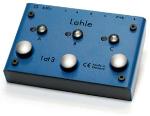
|
The Lehle 1at3 SGoS is a genuine True-Bypass Switcher that routes the incoming signal
to up to three outputs (e.g. amps, tuner, effects).
Output B and the C->B socket can be used as a loop, enabling you to switch instantly between the pure
original signal and the signal with effects.
The Lehle 1at3 SGoS can be controlled and synchronized with other Lehle SGoS Switchers via MIDI.
|
| LH31S |
Lehle 3@1 SGoS |
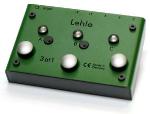
|
The Lehle 3at1 SGoS permits stereo switching, via gold-plated relays,
between up to 3 different instruments.
The signal is routed without any loss from Inputs A B or C to Outputs 1 and 2,
enabling you to switch easily between amp and tuner.
The Lehle 3at1 SGoS can be controlled and synchronized with other Lehle SGoS Switchers via MIDI.
|
| LHDLS |
Lehle D Loop SGoS |

|
The Lehle D.Loop SGoS is a fully programmable Effect Looper/
Switcher with two separate True-Bypass loops routed via gold-plated relays.
It includes a switchable high end buffer amp with adjustable gain up to +12 dB. Loops and buffer amp are both all-stereo.
The Lehle D.Loop SGoS can be controlled and synchronized with other Lehle SGoS Switchers via MIDI.
|
| LHDUS |
Lehle Dual SGoS |
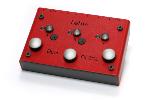
|
The Lehle Dual SGoS routes the signal via gold-plated relays to outputs A, B or T .
Outputs A and B can feed two different amps simultaneously since the signal paths are electrically
isolated by the Lehle LTHZ high-end transformer – completely eliminating humming loops.
In this case, the potentiometers enable you to lower the output signal for A and B separately.
Output T can be used for a tuner or a third amplifier.
Both inputs can be routed in stereo to Outputs A and B. In addition,
the Lehle Dual SGoS also incorporates gold-plated phase-reverse and ground switches.
The Lehle Dual SGoS can be controlled and synchronized with other Lehle SGoS Switchers via MIDI.
|
| LHLJ |
Lehle Little Julian |
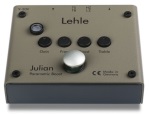
|
The Lehle Julian is an advanced Lehle Sunday Driver SW and offers additional controls like the parametric mids and treble.
It has developed into a versatile booster - especially with the vintage users in mind - to tickle the input of a tube amp.
The parametric midboost allows individual sound shaping as well as recreating the characteristics of familiar classics like the established Dallas Rangemaster or the Hornby Skewes Treble Booster,
supplying the ear with familiar sounds. Since these boosters had a very low input impedance we have equipped the Lehle Julian with a switch that reduces the impedance from 1 MOhm to 10
kOhm for authentic rendition of their characteristics.
The treble control completes the sonic performance. And the best: all settings from ''muffled'' to ''edgy'' are always pleasing, there is no dull or piercing sound.
The overdrive grade of the connected amp can be fine-tuned with the gain pot by +/- 15 dB ranging from super clean to distorted.
The Lehle Julian always delivers a clean output thanks to its JFET input stage.
Its personal dynamic derives from the fact that the incoming current is rectified, stabilized and doubled to 18V right after the powersocket.
In OFF status, the Lehle Julian provides two different modes of operation - in TB (= True Bypass) mode, the input and output are linked with zero losses to one another via a switch with gold-plated contacts.
True Bypass mode is the best option for a small set-up with short cable routings and when a classical fuzz pedal is looped in after the Lehle Julian.
The line-driver function, located at the start of the train or in an effect chain, is the better solution for long cables and for complex effect board configurations.
Running the Lehle Julian in TS mode (= True Sound) it becomes active as a buffer, but without amplifying or coloring the signal.
The Bypass mode option enables the Lehle Julian to integrate ideally into any set-up, whether as a battery-operated stand-alone unit, or in an existing pedal board.
|
| LHLD |
Lehle Little Dual |
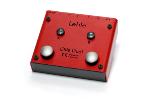
|
The Lehle Little Dual routes the signal via gold-plated switches to Outputs A or B.
Outputs A and B can feed 2 different amps simultaneously, since the signal paths are electrically
isolated by the Lehle LTHZ high end transformer – completely eliminating hum loops.
Both inputs can be routed in stereo to Outputs A and B separately.
In addition, the Lehle Little Dual also incorporates gold-plated phase-reverse and ground lift switches.
|
| LHLL |
Lehle Little Lehle II |
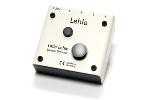
|
Little Lehle II The Little Lehle II is a genuine True Bypass looper/switcher.
It can be used to manage an effects loop, or as a simple A/B box.
Two instruments can be optionally routed to one amplifier input, or one instrument
switched back and forth between two amplifiers.
The gold-plated switcher contained in the unit switches with maximum signal fedelity.
The seperate switching level for ground contacts makes ground loops impossible.
Little Lehle II offer full stereo functionality with all jacks and internal switching contacts executed in stereo.
|
| LHMV |
Lehle Mono Volume |
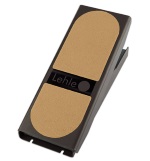
|
The Lehle Mono Volume is a volume pedal equipped with a precise magnetic sensor enabling it to operate almost wear-free.
This sensor uses the Hall effect, named after Edwin Hall, to measure the strength of magnetic fields. In the Lehle Mono Volume the Hall sensor, which is made in Germany,
is accurately calibrated to the built-in magnet and the control range of the pedal.
The pedal moves only the magnet, the distance is measured by the Hall sensor which controls a VCA.
A premium Blackmer VCA (= Voltage Controlled Amplifier) from the United States replaces here in this case the mechanical potentiometer.
The principle of the voltage-controlled amplifier is based on the fact that gain can be varied by the control voltage coming from the Hall sensor.
This technique allows to operate more precisely than conventional mechanical potentiometers or optical sensors used by the standard volume pedals.
In addition the potentiometer-typical noise and the complicated adjustment are eliminated.
Over the entire control range the Lehle Mono Volume transmits the full sound spectrum of the connected instrument.
The input and output impedance always stay the same, ensuring that there will be no damping of higher frequencies as with potentiometers.
Internally, the input voltage coming from the power supply socket of the pedal is rectified, then filtered, stabilized and doubled to 18V, thus achieving a total dynamic range of 110 dB.
The volume control of the Lehle Mono Volume ranges from -92 dB to 0 dB - so from a virtually muted level to the same volume. With a potentiometer a gain up to +10 dB boost can be additionally adjusted.
The Lehle Mono Volume runs mechanically extremely smooth and steady, as it is equipped with low-friction bearings of a high-performance polymer, and there is no mechanical
transmission of the pedal to other components. By means of an adjusting screw the mobility of the pedal can be modified very precisely.
Furthermore, the Lehle Mono Volume has a buffered direct out which can supply a tuner, DAW or a second amp without affecting the sound.
|
| LHMV90 |
Lehle Mono Volume 90 |
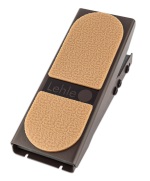
|
The Lehle Mono Volume 90 is a volume pedal equipped with a precise magnetic sensor enabling it to operate almost wear-free.
This sensor uses the Hall effect, named after Edwin Hall, to measure the strength of magnetic fields. In the Lehle Mono Volume 90, the Hall sensor, which is made in Germany,
is accurately calibrated to the built-in magnet and the control range of the pedal. The pedal moves only the magnet, the distance is measured by the Hall sensor which controls a VCA.
A premium Blackmer® CA (= Voltage Controlled Amplifier) from the United States replaces the mechanical potentiometer. The principle of the voltage-controlled amplifier is based on the
fact that gain can be varied by the control voltage coming from the Hall sensor. This technique allows to operate more precisely than conventional mechanical potentiometers or optical
sensors used by the standard volume pedals. In addition the potentiometer-typical noise and the complicated adjustment are eliminated.
Over the entire control range the Lehle Mono Volume 90 transmits the full sound spectrum of the connected instrument. The input and output impedance always stay the same, ensuring that
there will be no damping of higher frequencies as with potentiometers.
Internally, the input voltage coming from the power supply socket of the pedal is rectified, then filtered, stabilized and doubled to 18V, thus achieving a total dynamic range of 110 dB.
The volume control of the Lehle Mono Volume 90 ranges from -92 dB to 0 dB - so from a virtually muted level to the same volume. Using the MIN control, the minimum volume of the Lehle
Mono Volume 90 can be set within a range from mute 0% to 90% (-10 dB). Furthermore, a gain up to +12 dB boost can be additionally adjusted via the GAIN control.
The Lehle Mono Volume 90 runs mechanically extremely smooth and steady, as it is equipped with low-friction bearings of a high-performance polymer, and there is no mechanical transmission
of the pedal to other components. By means of an adjusting screw the mobility of the pedal can be modified very precisely.
In addition, the Lehle Mono Volume 90 has a buffered direct out which can supply a tuner, DAW or a second amp without affecting the sound.
In- and output jacks on the side of the pedal make the Lehle Mono Volume 90 an ideal device for pedal steel players - without any obstruction, the pedal can be placed in the usual spot on the pedal steel rack.
|
| LHSV |
Lehle Stereo Volume |
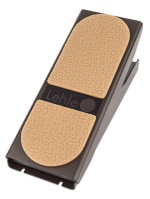
|
The Lehle Stereo Volume is a volume pedal equipped with a precise magnetic sensor enabling it to operate almost wear-free.
This sensor uses the Hall effect, named after Edwin Hall, to measure the strength of magnetic fields. In the Lehle Stereo Volume, the Hall sensor, which is made in Germany,
is accurately calibrated to the built-in magnet and the control range of the pedal. The pedal moves only the magnet, the distance is measured by the Hall sensor which controls a VCA.
A premium Blackmer® Stereo-VCA (= Voltage Controlled Amplifier) from the United States replaces here in this case the mechanical potentiometer.
The principle of the voltage-controlled amplifier is based on the fact that gain can be varied by the control voltage coming from the Hall sensor.
This technique allows to operate more precisely than conventional mechanical potentiometers or optical sensors used by the standard volume pedals.
In addition the potentiometer-typical noise and the complicated adjustment are eliminated.
Over the entire control range the Lehle Stereo Volume transmits the full sound spectrum of the connected instrument. The input and output impedance always stay the same,
ensuring that there will be no damping of higher frequencies as with potentiometers.
Internally, the input voltage coming from the power supply socket of the pedal is rectified, then filtered, stabilized and doubled to 18V, thus achieving a total dynamic range of 110 dB.
The volume control of the Lehle Stereo Volume ranges from -92 dB to 0 dB - so from a virtually muted level to the same volume.
The Lehle Stereo Volume runs mechanically extremely smooth and steady, as it is equipped with low-friction bearings of a high-performance polymer, and there is no mechanical
transmission of the pedal to other components. By means of an adjusting screw the mobility of the pedal can be modified very precisely.
The Lehle Stereo Volume can both distribute one signal to two outputs and add up two input signals to one output: If only a mono signal is supplied, the signal can be split and sent
to two different output channels using the split-function. An input stereo or a dual-mono-signal can be merged to mono via the summing function. The balanced (TRS) as well as
unbalanced (TS) outputs make the Lehle Stereo Volume fit for use in studios or FOH-environment, e.g. to control the amount of real-time effects or signal busses.
|
| LHPS |
Lehle P-Split II |
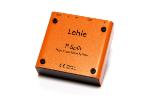
|
Lehle P-Split stands for ''passive splitting''with maximum signal fidelity.
Making it possible to route an instrument can be routed to two amplifiers simultaneously.
Output A is electrically isolated from Output B by the Lehle LTHZ high end transformer – so ground
loops are excluded from the start. In addition, the Lehle P-Split II also features a gold-plated-contact
phase-reversing and ground switch.
|
| LHPL |
Lehle Lehle Linemixer for Parallel Effects Loops with True Bypass switch |
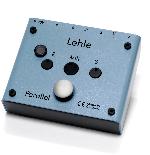
|
The latest member of the Lehle Gitarrentechnik product family is the Lehle Parallel,
a compact and versatile line mixer that meets the highest sound standards.
The Lehle Parallel is just right when you want to mix effect sounds, for example, in parallel to your original signal,
whether before the amp or into its serial effects loop.
Use the MIX controller to set the ratio between effect and original sound just how you want it.
The great dynamic range permits connection both of a low-impedance 19'' studio effect and standard effect pedals.
Another typical use is connection of two pick-up systems, from an acoustic guitar or a double bass, for example
(microphone + piezo, piezo + soundhole pick-up, etc.).
With the Lehle Parallel, you can match the two signal sources optimally with one another and -
thanks to the Lehle Parallel's outstanding audio qualities - relay them on with no loss of dynamic scope to your amplification system.
The Lehle Parallel's inputs can handle high-impedance signals from electric guitars and basses,
and acoustic instruments fitted with pick-ups, just as easily as low-impedance signals from keyboards and active
electric guitars and basses - with the excellent transmission frequency range of 20 to 100,000 Hz! And - so that you
get all the dynamics of your tube amplifier - the input voltage is rectified, filtered,
stabilized and then doubled to 18V after the power-supply socket.
Lehle Parallel L, is a pure line Mixer which is equipped with an additional True Bypass footswitch.
|
| LHPM |
Lehle Linemixer for Parallel Effects Loops without true bypass switch |
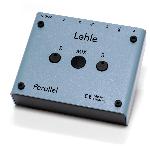
|
The latest member of the Lehle Gitarrentechnik product family is the Lehle Parallel,
a compact and versatile line mixer that meets the highest sound standards.
The Lehle Parallel is just right when you want to mix effect sounds, for example, in parallel to your original signal,
whether before the amp or into its serial effects loop.
Use the MIX controller to set the ratio between effect and original sound just how you want it.
The great dynamic range permits connection both of a low-impedance 19'' studio effect and standard effect pedals.
Another typical use is connection of two pick-up systems, from an acoustic guitar or a double bass, for example
(microphone + piezo, piezo + soundhole pick-up, etc.).
With the Lehle Parallel, you can match the two signal sources optimally with one another and -
thanks to the Lehle Parallel's outstanding audio qualities - relay them on with no loss of dynamic scope to your amplification system.
The Lehle Parallel's inputs can handle high-impedance signals from electric guitars and basses,
and acoustic instruments fitted with pick-ups, just as easily as low-impedance signals from keyboards and active
electric guitars and basses - with the excellent transmission frequency range of 20 to 100,000 Hz! And - so that you
get all the dynamics of your tube amplifier - the input voltage is rectified, filtered,
stabilized and then doubled to 18V after the power-supply socket.
Lehle Parallel M, a straight mixer.
|
| LHSD |
Lehle Sunday Driver |
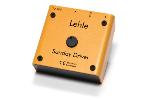
|
The Lehle Sunday Driver is a high end preamp with a convenient compact format.
It features JFET-based circuitry and provides two modes of operation, with selection via a mode selector
switch with gold-plated contacts: ''D'' stands for Driver; in this mode, the guitar signal is amplified,
with absolutely no modification, at the input impedance of a guitar amp, efficiently eliminating losses
on the route through leads and effects; the signal remains strong and clear, retaining its full dynamics.
The second setting ''S'' - as in Sunday - multiplies input impedance by four, bringing out previously
inaudible details and, as gain increases, imparting to the guitar sound a characteristic and unmistakable
warmth that has given this preamp its name - the result is a sound as mellow as a sunny Sunday afternoon!
Even at a 15dB gain setting, the Lehle Sunday Driver always stays clean and absolutely free of background noise,
thanks to its studio-standard signal-to-noise ratio of over -100 dB.
To exploit the dynamics of tube amplifiers to the full, the input voltage is also rectified from the
power supply socket, then filtered, stabilized and doubled to 18V.
With its broad output range of 20 to 100,000 Hz, the Lehle Sunday Driver,
powered by a standard 9V (PP3) battery, can be used anywhere, whether as a cable driver for stadium and other large stages,
in complex effects set-ups, or as a recording preamp - and not just Sundays!.
|
| LHSDSW |
Lehle Sunday Driver SW |
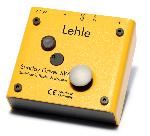
|
The Lehle Sunday Driver SW is a compact-format high-end preamp for all types of electrical and acoustic
instruments - a preamp that enables electric guitars and basses, acoustic guitars, and also other stringed instruments (such as violins,
cellos and double basses) to realize all of their musical potential. The switchable version expands the classical Lehle Sunday Driver's features
by an On/Off footswitch.
The Lehle Sunday Driver SW, with its high-quality JFET technology, provides two operating modes. In D (= Driver) mode, the input signal is amplified
with zero modification, to eliminate the signal losses that long cable routings and/or effects chains can cause. The signal remains powerful and clear,
and retains its dynamics. Mode S (= Sunday) multiplies input impedance by four, bringing out previously inaudible details and, as gain increases,
imparting to the guitar a characteristic and unmistakable warmth. There is no distortion at any stage, and the signal always stays clean, even at a
maximum gain setting of 15 dB. Thanks to its studio-standard signal-to-noise ratio of better than -100 dB, the Lehle Sunday Driver SW is totally
free of background noise. To exploit the dynamics of tube amplifiers to the full, the input voltage is also rectified from the power supply socket,
then filtered, stabilized and doubled to 18V.
In OFF status, the Lehle Sunday Driver SW provides two different modes of operation - in TB (= True Bypass) mode, the input and output are linked
with zero losses to one another via a switch with gold-plated contacts. True Bypass mode is the best option for a small set-up with short cable routings
and for when a treble-booster or a classical fuzz pedal is looped in after the Lehle Sunday Driver SW. The line-driver function, located at the start
of the train or in an effect chain, is the better solution for long cables and for complex effect board configurations. Switch the Lehle Sunday Driver
SW to TS (= True Sound) mode, and it is active as a buffer, without amplifying or modifying the signal in any way. In this mode, the Lehle Sunday Driver
SW operates as a totally neutral line-driver - equivalent to Mode D with the gain pot turned all the way to the left. The Bypass mode option enables
the Lehle Sunday Driver SW to integrate ideally into any set-up, whether as a battery-operated stand-alone unit, or in an existing pedal board.
|
| LHSDXLR |
Lehle Sunday Driver XLR |
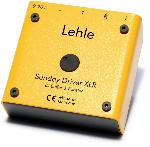
|
The Lehle Sunday Driver is a high end preamp with a convenient compact format.
The Lehle Sunday Driver XLR is a compact-format high-end preamp for all types of electrical and acoustic instruments - a preamp that enables
electric guitars and basses, acoustic guitars, and also other stringed instruments (such as violins, cellos and double basses) to realize all
of their musical potential. The XLR variant adds a symmetrical XLR output and a ground-lift switch to the classical Lehle Sunday Driver spec.
On stage, it can be used as a compact DI box, and as a line-driver for long cable distances. In studio use, its broad output range of 20 to 100,000
Hz makes it ideal as a recording preamp or as a DI box, whether as a battery-operated stand-alone unit, or integrated into existing setups.
The Lehle Sunday Driver XLR, with its high-quality JFET technology, provides two modes, which are selected using a switch with gold-plated contacts.
In mode D (= Driver), the input signal is amplified with absolutely no modification. This eliminates the signal losses that long cable routings
and/or impedance matching errors with high-impedance signals from passive pick-ups can cause. The signal remains powerful and clear, retaining its
dynamics and brilliance. Mode S (= Sunday) multiplies input impedance by four, bringing out previously inaudible details. As gain increases on
the Lehle Sunday Driver XLR, the sound takes on an unmistakable and characteristic warmth. There is no distortion at any stage, and the signal
remains clean at all times, even at the maximum gain setting of 15 dB. To exploit the dynamics to the full, the input voltage is rectified from the
power supply socket, filtered, stabilized and then doubled to 18V. The Lehle Sunday Driver XLR is totally free of background noise,
thanks to its studio-standard signal-to-noise ratio of better than -100 dB.
|
| LHDC0.6 |
Lehle MIDI SGoS DIN Cable 0.6m to 1/4 stereo plug w/Neutrik connector |

|
Lehle MIDI Cable
These MIDI cables are used to connect Lehle SGoS Switcher to standard MIDI equipment.
The robust cables, with their metal TRS and DIN connectors,length 0.6m
|
| LHDC1 |
Lehle MIDI SGoS DIN Cable 1m to 1/4 stereo plug w/Neutrik connector |

|
Lehle MIDI Cable
These MIDI cables are used to connect Lehle SGoS Switcher to standard MIDI equipment.
The robust cables, with their metal TRS and DIN connectors,length 1.0m
|
| LHDC6 |
Lehle MIDI SGoS DIN Cable 6m to 1/4 stereo plug w/Neutrik connector |

|
Lehle MIDI Cable
These MIDI cables are used to connect Lehle SGoS Switcher to standard MIDI equipment.
The robust cables, with their metal TRS and DIN connectors,length 6m
|
| LHDC10 |
Lehle MIDI SGoS DIN Cable 10m to 1/4 stereo plug w/Neutrik connector |

|
Lehle MIDI Cable
These MIDI cables are used to connect Lehle SGoS Switcher to standard MIDI equipment.
The robust cables, with their metal TRS and DIN connectors,length 10m
|
| LHDC-F |
Lehle DC-Filter - Stereo Filter for DC Offset in audio signals |

|
Lehle MIDI Cable
The Lehle DC Filter eliminates DC voltage from analog signals.
Audio signals containing DC voltage cause ugly switching noise.
Now, both line and high-impedance signals are cleaned - but with no loss of sound.
The DC Filter is of full stereo type, and thus filters stereo - and, of course, mono - signals.
This little aid can even process balanced signals. The Lehle DC Filter is a passive filter, so it needs no power supply.
|
|